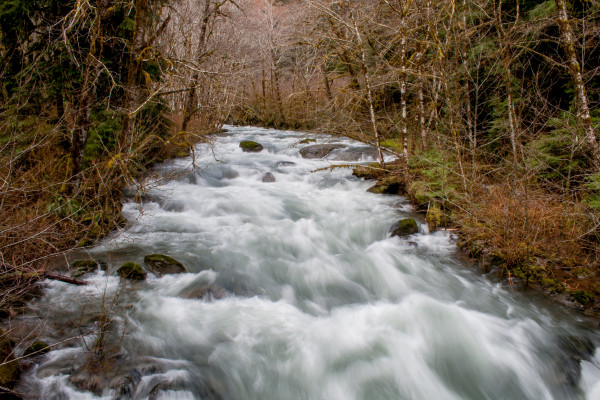About
The Siletz River is home to an array of unique plant and animal species, including Sitka Spruce, Silver Spotted Butterfly, Bald Eagle, Spotted Owl, Marbled Murrelet, Gian Pacific Salamander, Freshwater Mussels, Within this watershed is the Valley of the Giants, an area of Critical Environmental Concern designated for exceptional natural resource values because of it's old growth forests, fish and wildlife habitat and historic cultural resources. Drift Creek, a tributary of Siletz Bay is managed as a tier one watershed by the Siuslaw National Forest and has been selected for possible designation as a Wild and Scenic River. The Siletz watershed, while boasting the greatest diversity in fish species on the Oregon Coast, as it contains all types of salmonid species, as well, white sturgeon inhabit the lower river and bay. The Siletz's unique climate also allows for some of the fastest growing coniferous forests in Oregon. Unfortunately, this Watershed has also been deemed the most deforested watershed in Oregon and has the largest density of roads in the state, largely as a result of poor private timber practices.
Basin Statistics
Location: Oregon’s Mid-Coast
Major Contributing Streams: Siletz River, Drift and Schooner Creeks
Siletz River Length: 67.5 miles
Drainage: 197,120 acres
Drift Creek Length: 18 miles
Drainage: 48,000 acres
Schooner Creek Length: 12 miles
Drainage: 9,650 acres
Threats:
Significant summer and winter steelhead hatchery interactions, which negatively impact wild runs. An average 90% of the summer steelhead present annually within the Siletz River is of hatchery origin. Stray rates are well above 10% as outlined in the HGMP’s, sometimes reaching up to 70% or higher, with some fish straying into the upper Siletz above the falls, diluting wild summer steelhead genetics.
Poor Ladder and trap management at the Siletz Falls creating hybridization of winter and summer run steelhead which threatens the validity of a true independent Wild Summer run of steelhead above the Siletz Falls.
Widespread poor private land use practices degrading tributary, riparian, and in stream habitat along the majority of the Siletz River as is portrayed in North Fork Studios, “River Of Hope” below.
Ongoing plans of creating a dam on the south fork of the Siletz with diversion of water to the Willamette Valley.
Siltation and massive alteration of the Valsetz valley leaving the South Fork of the Siletz lacking suitable fish habitat to support increased Wild Summer Steelhead populations.
Significantly increased in stream temperatures (303d listed for both the Siletz River and Drift Creek) throughout the river system.
Decreased estuarine habitat complexity from siltation of the bay due to poor logging practices, diking and channelizing throughout the bay, and blocking of historic habitat.
Unique and small run of wild summer steelhead face serious genetic introgression from current hatchery management practices combined with significant loss/degradation of their historic habitat limits their population holding capacities and robustness.
Drift Creek Siletz has the highest road density within the Siuslaw National forest. This increases erosion processes while also creating multiple trigger points for landslides while also altering natural water sedimentation rates within the watershed.
The Siletz River, Drift and Schooner Creeks all have limited in stream complexity and large woody debris, which limits all anadromous fish rearing capacities throughout the basin.
Partners:
News Articles
Counties Considering New Dam in Coast Range: Oregon Public Broadcasting
Oregon Proposes Removing Hatchery Fish From Wild Fish Areas: Oregon Public Broadcasting
Accomplishments
Submitted comments during the Coastal Management Plan Review Period helping close Drift Creek (Siletz) to Chinook fishing During the Summer months so as to protect a very small run of Spring Chinook that persist in this stream. These comments were based on a recent genetic analysis exploring Chinook populations within the Siletz basin.
Submitted comments during the Coastal Management Plan Review Period in favor of removing or decreasing summer steelhead hatchery plants in the Siletz River. This action helped was successful in that ODFW has decreased hatchery steelhead releases from 80,000 to 50,000 fish.
Rallied together a group of constituents committed to seeing the Drift Creek (Siletz) North Creek Culvert project reach completion. This project is scheduled for completion the summer of 2018.
For more information regarding the Siletz River Basin visit these links:
Siletz Bay National Wildlife Refuge Comprehensive Conservation Plan
Siletz River Summer Steelhead Hatchery and Genetic Management Plan
Siletz River Winter Steelhead Hatchery and Genetic Management Plan
Relative Susceptibility of Four Strains of Summer Steelhead to Infection by Ceratomyxa shasta
Siletz River Summer Steelhead Study (Oregon State University)
South Fork Siletz Dam Planning (Oregon Water Resources Department)
Trout Unlimited Bluebacks Siletz Summer Steelhead Monitoring
Midcoast Watershed Council --North Creek Culvert Project Page
Lincoln County Schooner Creek (Siletz) Watershed Information

